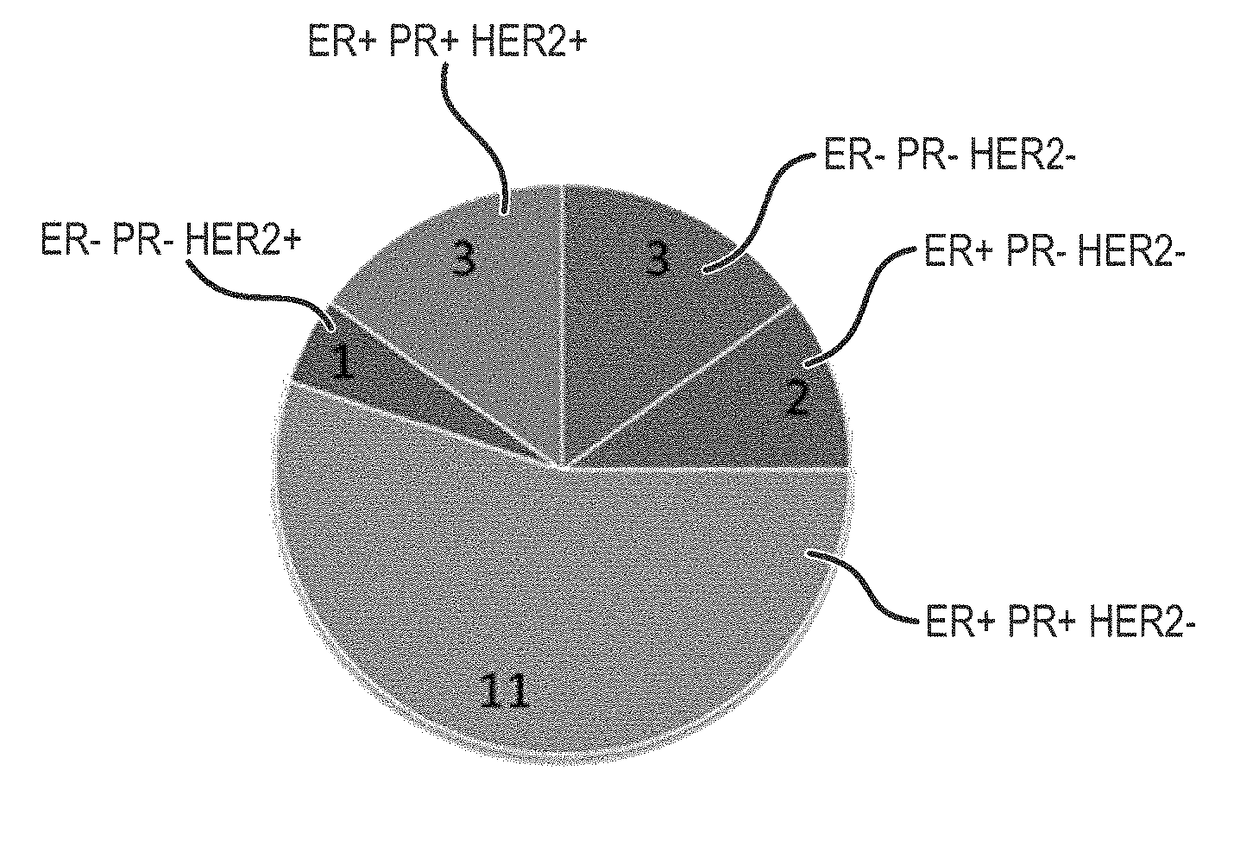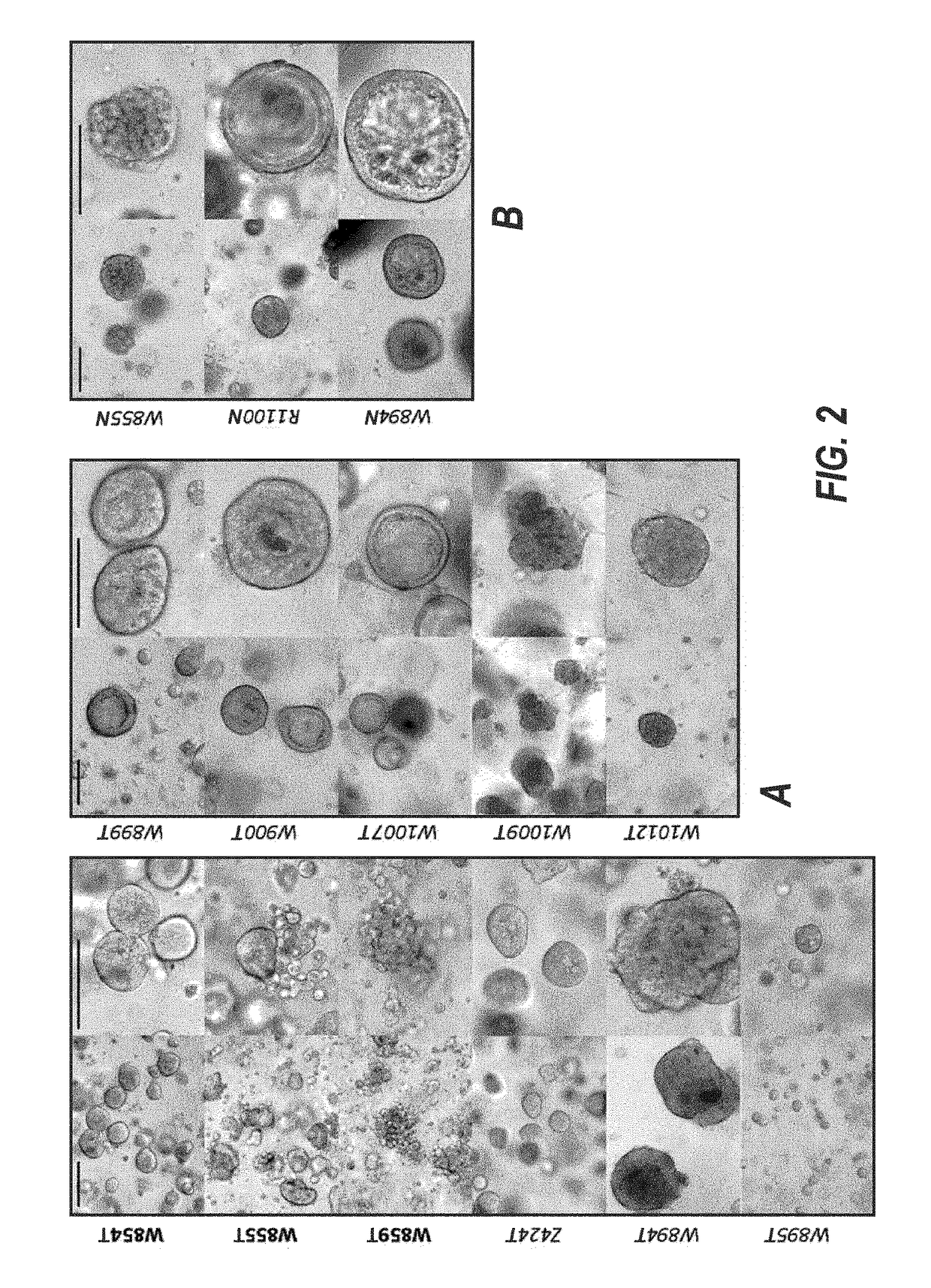Culture medium for expanding breast epithelial stem cells
- Summary
- Abstract
- Description
- Claims
- Application Information
AI Technical Summary
Benefits of technology
Problems solved by technology
Method used
Image
Examples
example 1
ocessing and Mammary Organoid Culture
Overview
[0365]20 breast tumors were sampled, three of which were triple negative (15%, FIG. 1A and FIG. 13). We successfully established three tumor organoid lines (splitting ratio >1:2, passage >7). 8 additional cultures are currently expanding and will, based on our experience, most likely generate successful organoid lines (FIG. 2 and FIG. 13). A selection for a specific subtype is not evident (FIG. 1B).
[0366]From the 19 normal samples obtained we thus far established three promising cultures (FIG. 2, FIG. 13).
Culture Conditions
[0367]The first 12 samples were used to optimize cell isolation and organoid culture conditions. Samples 13-20 were grown in six different conditions.
Altered Parameters for Cell Isolation
[0368]For the isolation of viable cells we tested several digestive enzymes (collagenase, dispase, trypsin) at different concentrations (1-5 mg / ml) in different media (AdDF+++, base medium, base-F7 / 10N medium) for different periods of t...
example 2
ization of Established Mammary Tumor Organoid Lines
[0372]Mammary tumor organoid lines W854T, W855T, and W859T readily expand in base-F7 / 10N medium and were therefore characterized in more detail.
[0373]Their tumor status was confirmed through karyotyping revealing aneuploidy at varying degrees (FIG. 4).
[0374]Line W854T furthermore readily grew in medium containing 5 μM Nutlin-3 indicating the presence of mutant p53. RNA and DNA were isolated and sent to BI for gene expression profiling and exome sequencing.
[0375]Histological and immunofluorescent analysis confirmed that ER, PR, and HER2 status are conserved between originating tumor and established tumor organoid line after >7 passages (FIGS. 5 and 6).
[0376]Whereas normal organoid line W855N consists of mutually exclusive basal and luminal cells, tumor organoids solely express luminal cell marker Keratin-8 (FIGS. 6 and 7). E-cadherin expression is present but decreased in tumor compared to normal organoid lines indicating their epith...
example 3
ghput Drug Screen
[0377]To test the feasibility of mammary tumor organoids for drug screening, lines W854T, W855T, and W859T were plated in duplicate into a 96-well format and exposed to medium containing the EGFR inhibitor Iressa (1 nM-30 μM at 1:3 dilution steps, S1025 Selleck Chemicals) or the p53 stabilizer Nutlin-3 (1 nM-30 μM at 1:3 dilution steps, 10004372 Cayman Chemicals) for 7 days. Organoids were photographed every 3-4 days (FIG. 8) and cell viability measured at day 7 using the CellTiter-Glo 2.0 assay (G9241, Promega) (FIG. 9).
[0378]All three organoid lines respond to Iressa at concentrations ˜10 μM indicating a dependence on EGFR signaling. With perhaps the exception of W855T, Nutlin-3 does not inhibit growth at concentrations up 30 μM indicating the presence of mutant p53 (FIG. 9). Mammary tumor organoids are suitable for cell viability based low throughput drug screens in a 96-well format. We are currently testing the assay in a 384-well plate format which has been suc...
PUM
 Login to View More
Login to View More Abstract
Description
Claims
Application Information
 Login to View More
Login to View More - Generate Ideas
- Intellectual Property
- Life Sciences
- Materials
- Tech Scout
- Unparalleled Data Quality
- Higher Quality Content
- 60% Fewer Hallucinations
Browse by: Latest US Patents, China's latest patents, Technical Efficacy Thesaurus, Application Domain, Technology Topic, Popular Technical Reports.
© 2025 PatSnap. All rights reserved.Legal|Privacy policy|Modern Slavery Act Transparency Statement|Sitemap|About US| Contact US: help@patsnap.com



